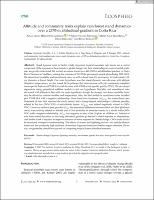Altitude and community traits explain rain forest stand dynamics over a 2370-m altitudinal gradient in Costa Rica
Date
12-2021Auteur
Hernández Gordillo, Alba Lorena
Vilchez Mendoza, Sergio
Ngo Bieng, Marie Ange
Delgado, Diego
Finegan, Bryan
Sustainable development goals
ODS 13 - Acción por el clima
Type
Artículo
Metadata
Afficher la notice complèteRésumé
Stand dynamic rates in Earth’s vitally important tropical mountain rain forests are a central component of the response of these forests to global change, but their relationships to environmental gradients are poorly understood. We worked in mature forests on a 440–2810 m asl altitudinal gradient on Costa Rica’s Talamanca Cordillera, making five censuses of 29 0.25-ha permanent sample plots during 2012–2019. We determined mortality and recruitment rates, as well as basal area (G) increments, for individuals ≥10 cm diameter at breast height. Our main hypothesis was that stand dynamic rates decrease with altitude (therefore temperature); we also tested the hypotheses that rates increase with plot community-weighted mean specific leaf area (CWM SLA) and decrease with CWM wood specific gravity (WSG). We developed regressions using generalized additive models to test our hypotheses. Mortality and recruitment rates decreased with altitude in line with our main hypothesis, though the strongly non-linear mortality trend may be driven by extreme weather and temperature. Also, the best model for recruitment rates included plot CWM SLA with a negative relationship. Gross basal area increment ΔGgross, the annual basal area increment of trees that survived the study period, had a hump-shaped relationship to altitude, possibly related to the low CWM WSG of mid-altitude forests. ΔGgross was indeed negatively related to CWM WSG. However, net basal area growth (ΔGnet, the annualized difference between initial and final plot basal areas) was positively related to altitude due to low mortality in montane forests, in a model with CWM
WSG with a negative relationship. ΔGnet was negative in nine of the 29 plots at <1500 m asl. Patterns of rain forest stand dynamics on this long altitudinal gradient go beyond a direct response to temperature, and further work is required to improve scenarios of forest response to climate change. CWM traits should be measured to improve understanding. The effects of storms and lightning on low- and middle-altitude forest and the potentially high resilience of montane Fagaceae-dominated forests require attention. Diversity, not generality, should be expected on comparing tropical forest altitudinal transects.
Keywords
Delegation
Sede Central
ORCID-ID
Alba Lorena Hernández Gordillo https://orcid.org/ 0000-0001-9769-945X
Bryan Finegan https://orcid.org/ 0000-0002-7035-255X
Is part of
Ecosphere, 12 (12)
Status
openAccess
xmlui.dri2xhtml.METS-1.0.item-uri-link
https://doi.org/10.1002/ecs2.3867


